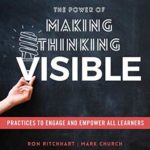I’ve been teaching for several centuries now. You’d think my students would believe me when I tell them how to make their sentences better. Or how to interpret literary passages. Or how to succeed in life.
Why don’t they?
Recent research suggests one potential answer: because my advice isn’t very good.
Here’s the story…
London Calling
A research team in London, led by PhD student Madeleine Moses-Payne, looked at research into adolescent metacognition: their ability to assess the correctness of their own judgments.
And, they looked at teens’ willingness to accept advice — good and bad — from adults.
In this case, the metacognition and “advice” were about a kind of space-themed video game. The participants had to determine — as quickly as possible — if there were more of species X or species Y on a planet.
The species were simply blobs in different colors. So, the participants made a snap judgment: are there more blue or more yellow blobs on the screen? (You can see some images from the study here.)
After the participants made their guess, they then rated their own confidence in their judgment; that’s the metacognition part.
And occasionally they got guidance from a “space advisor,” saying either “there are more blue blobs” or “more yellow blobs.” Most of the time (70%) the advisor was correct; 30% it was wrong.
What did researchers learn by putting all these variables together?
This Depends on That
Moses-Payne’s methodology included 3 age groups: children (8-9 years old), early adolescents (12-13), and late adolescents (16-17).
She wanted to know if data patterns changed with time. Here’s what she found:
First: adolescents (both early and late) were better at metacognition. That is, their confidence in their judgment aligned more precisely with the quality of their guesses, compared to the children.
Second: adolescents rejected more adult advice than children did.
And, here’s the kicker:
Third: adolescents rejected more bad advice.
That is: children lacked metacognitive certainty in the correctness of their judgements. Therefore, they let adult advice — even bad advice — sway their decision making.
However, adolescents had more accurate metacognitive confidence in their judgment. Therefore, they accepted good advice when they weren’t certain, but rejected bad advice when they were certain.
In Moses-Payne’s pithy summary:
adolescents, in contrast to children, take on others’ advice less often, but only when the advice is misleading.
So: why do my students resist my advice? Maybe they resist it when I’m wrong…
Not So Fast
So far, this research design makes a lot of sense, and leads to a helpful — and usefully provocative — conclusion.
At the same time, I think we should notice the important limitations of its conclusions.
In this research, the “advice” was either a correct or an incorrect answer about perceiving the relative number of colored blobs on a screen.
It was not, say, advice about career choice, or about the best strategy to use when solving a math problem, or about when to listen to your mother. (ALWAYS listen to your mother.)
Most of the time, in fact, we don’t use the word “advice” to describe information that’s factually correct or incorrect. “Advice” is usually an experienced-based opinion, not the correct answer to a question.
And so: this research does provide a helpful look at adolescent development.
Teens improve their metacognitive awareness of their own right/wrong answers.
They can use that information to guide decision making effectively.
It does NOT, however, give us a comprehensive new framework for thinking about advising teens (“Don’t worry if they reject your advice — it must have been wrong if they did!”).
I suspect adults will still give teens advice. And, they’ll accept some and reject some. And we’ll still be puzzled when they do.
And — if we’re high school teachers — we’ll still think they’re awesome anyway.




